Revista Electrónica de Investigación Educativa
Vol. 10, Num. 1, 2008
Analysis of Patterns of Interaction and Knowledge
Construction in On-Line Learning Environments:
A Methodological Strategy
Benilde García Cabrero
(1)
benilde@servidor.unam.mx
Luis Márquez Ramírez
(1)
luis.luismarquez@gmail.com
Alfonso Bustos Sánchez
()
abustos@ub.edu
Germán Alejandro Miranda Díaz
(3)
gamd@unam.mx
Susana Mabel Espíndola
(4)
suespindola@yahoo.com
1
División de Estudios de Posgrado
Universidad Nacional Autónoma de México
Av. Universidad 3004
Col. Copilco-Universidad, Coyoacán, 04510
México, D. F., México
2
Departamento de Psicología Evolutiva y de la Educación
Facultad de Psicología
Universidad de Barcelona
Pg. Vall d'Hebron, 171
Ponent, Despatx 3319
08035 Barcelona, España
3
Facultad de Estudios Superiores Iztacala
Universidad Nacional Autónoma de México
Av. de los Barrios No 1, Los Reyes Iztacala, 54090
Tlalnepantla, Estado de México, México
4
Facultad de Filosofía y Letras
Universidad Nacional Autónoma de México
Circuito Interior, Ciudad Universitaria, Coyoacan, 04510
México, D.F., México
(Received: September 23, 2007;
accepted for publishing: January 22, 2008)
Abstract
A model of analysis of interaction and construction of knowledge in educational environments based on computer-mediated communication (CMC) is proposed. This proposal considers: 1) the contextual factors that constitute the input and the scenario of interaction, 2) the interaction processes: types of interaction and its contents (Garrison, Anderson and Archer, 2000) as well as the discursive strategies (Lemke, 1997), and 3) learning results that involve the quality of the knowledge constructed by the participants (Gunawardena, Lowe and Anderson, 1997). This model was applied to the analysis of the interaction among a group of participants in two web forums (with or without the presence of a teacher), during the teaching of a PhD in Psychology program. The results show evidence of the model’s viability to describe the patterns of interaction and the levels of construction of knowledge in web forums.
Key words: Computer mediated communication, on-line interaction, computer mediated learning.
Introduction
According to the work of various educational researchers, despite an increase in the frequent use of learning environments supported by Computer-mediated Communication (CMC), the body of theoretical, methodological and empirical knowledge, which explains how we learn with the support of technology, is limited and fragmented. This points to the need for extending efforts to examine the variables involved in teaching and learning in these environments, as well as the opportunities and constraints they pose to the educational process (Barab, Kling and Gray, 2004, Graham and Misanchuk, 2004).
One of the advantages that have been attributed to CMC is the increased interaction between teachers and students, since it permits the extension of the time and work space normally used in classrooms, potentially generating greater opportunities for learning. However, it should be noted, as Eastmond has stated (1995), that CMC is not interactive in itself. Rather, its interactivity depends on the instructional proposal, which must explicitly describe the frequency, length and nature of interactions that have to be performed with the platform. Moreover, to promote the interaction it is necessary to create a social climate that provides cognitive and social support to the students (and Hawisher Pemberton, 1997).
Garrison and Cleveland-Innes (2005) indicate that interaction is the central aspect of an educational experience, and when trying to promote the development of reflection and critical thinking through modeling and scaffolding, more systematic and structured interaction is required. Fishman (2000) has argued that the use students make of the tools provided by CMC, is influenced more by the way teachers structure, support and develop activities, and by their skills and previous experience in the use of computers, than by the nature of the means of communication and technological resources. Similarly, Clark (1983.1994) has indicated that the method or instructional design is the "active ingredient" of learning.
Other researchers, such as Kozma (1994), have argued that the latest uses of technological resources and the potential they entail, diversify educational situations, potentializing or significantly limiting interaction models, and therefore are not neutral. Gunawardena, Lowe and Anderson (1997), however, contend that only in the context of instructional designs that make effective use of technological resources, and in which teachers create an environment that leads to a high level of interactivity and autonomy on the part of learners, does interactivity constitute a real factor in the construction of knowledge.
In the case of online learning, when the instructional design is particularly well adjusted to the needs of students, it is possible to promote learning, especially given the asynchronous nature of the communication, which facilitates the attainment of higher levels of reflection on the contents of the course (Chickering and Ehrmann, 1996).
In view of the fact that the use of CMC is rooted in particular contexts of teaching and learning, and that its use must respond to the participants' needs for interaction, according to the proposed instructional design, it is fundamentally important to develop methodological proposals for analyzing the tasks and the roles of the participants in these frameworks. These studies must be oriented toward the identification of recognizable patterns in the students' uses of the technological tools, and toward a comprehension of the relationship these patterns have with the teachers' intent and involvement. The success of the pedagogical activities will depend on what Coll (2004) has called the "techno-pedagogical" design, having to do with the abilities of the participants to use the technological tools, their knowledge of the contents, their learning focus: superficial or deep (Cleveland-Innes and Emes, 2005); of their cognitive strategies and communicative abilities. Likewise, in view of the fact that the fundamental resource used in CMC is written discourse, it is necessary to study the forms adopted by this discourse, as well as its impact on the construction of knowledge (Garrison, Anderson and Archer, 2000). Because of this, is it necessary to design or adapt the methodologies of analysis which have traditionally been used for the study of discourse interactions in the classroom, taking into account the variables and characteristics that enter into these informatics-based frameworks (Garrison y Anderson, 2003).
One of the advantages that have been attributed to CMC is the increased interaction between teachers and students, as an extension of the time and workplace normally used in classrooms, potentially generating greater opportunities for learning. However, it should be noted, as stated Eastmond (1995), the CMC is not interactive in itself, but rather depends on the interactivity of the proposed instruction, which must explicitly describe the frequency, length and nature of interactions performed with the platform. Moreover, to promote interaction, it is necessary to create a social climate that provides cognitive and social support to students (and Hawisher Pemberton, 1997).
In reviewing the literature on the analysis of interaction in CMC environments, we see two major methodological trends. In the first are located the studies focused on an analysis of the viable use of environments (Jong-Baeg, Derry, Steinkuehler, Street and Watson, 2000), primarily centered on a determination of the level of user satisfaction. The second approaches studies on the quality of interactions, including analysis of the content of messages and arguments (Gunawardena et al., 1997; Järvelä and Häkkinen, 2002), the types of messages (Garrison et al. , 2000) and the pedagogical and discourse strategies, and the discourse used by participants to support the construction of knowledge (Lemke, 1997).
Based on the information above, it is necessary to conduct research that will enable us to understand how it is that users interact with the resources provided by CMC, and what variables are involved in this process. According to Barab and Plucker (2002), in education we are now moving away from the cognitive theory, which emphasizes individual thinking and isolated minds, and toward those theories which emphasize the situational nature of cognition and meaning, from which is proposed the creation of learning communities, or as recently denominated in online and distance education, "indagative communities", as proposed by Garrison et al. (2000).
An indagative community is more than just a social community and, more, even, than the size of the group or the amount of interaction among participants. It is the integration of the cognitive, social and teaching presence. According to Garrison et al. (2000), in order to assess the quality of learning it is necessary to understand how to combine these three types of presence so that they operate together to create a powerful research community. The authors note that since the interaction itself does not ensure that students are cognitively engaged in an educationally significant manner, it requires cognitive presence (Garrison et al., 2000) to ensure effective interaction. This kind of presence refers to the degree to which participants in an indagative community are able to construct meanings through mutual communication. An indagative community also includes, in addition to the cognitive presence, a social presence which includes social interchange and the network of positive relationships which permit the creation of a positive atmosphere in the community and promote cognitive learning among participants.
As to the teaching presence, it focuses on exploration, the integration and testing of concepts and solutions. In relation to the role played by the teacher, Garrison and Cleveland-Innes (2005) demonstrated the importance of both the instructional design proposed by the teacher and his/her active participation to promote interaction and critical discourse in online learning.
I. Methodology for analyzing interaction in CMC environments
This proposal seeks to describe and analyze the factors and processes involved in the effectiveness of online learning communities. The proposal is based on the model developed by Benbunan-Fich, Hiltz and Harasim (2005); however, it raises the question of some differences related to the emphasis given to the factors associated with instructional design, and the types, content and strategies of interaction related with the construction of knowledge (see Figure 1).
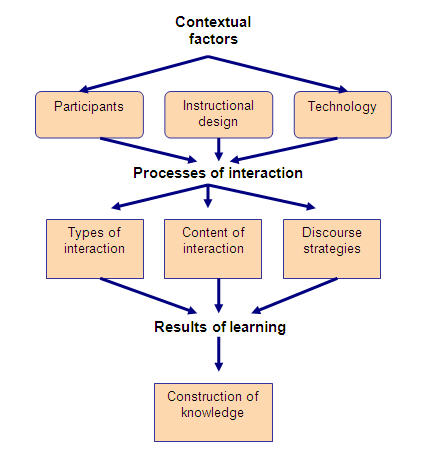
Figure 1. Methodological strategy for analyzing the interaction in CMC environments
1.1. Contextual factor
The characteristics of the participants, the instructional design and technological resources constitute the input of the CMC environment, which encourage or limit both the interaction and the results of learning. The contextual factors considered are the following:
1.1.1 Participants
The characteristics of students and teachers exert a decisive influence on interactions and learning results.
Characteristics of Students: knowledge of the subject, cognitive literacy technology and meta-cognitive skills, learning styles, personality factors, attitudes toward new technology, motivation, self-esteem, sense of auto-efficiency, group size.
Characteristics of the teacher: knowledge of the issue, management skills in technology, teaching strategies, attitude towards the use of new technologies, personality factors, discourse skills.
1.1.2. Instructional design
Includes educational devices, in which are specified the actions and instructional arrangements and instructional activities designed by the teacher to organize the use of technological tools, teaching strategies (Garcia, Secundino and Navarro, 2000), the administration of time and space, and the use of strategies.
Characteristics of learning content: Theme, language, complexity.
Predicted uses of the technological platform: Mixed mode, on-line, etc.
Pedagogical strategies: Activities, materials, etc.
Temporal delimitation of activities: Time of participation in the forums, deadlines for turning in assignments, participation schedules.
Incentives provided for the participation in and contribution to activities.
Evaluation strategies for learning activities.
1.1.3 Technology
Communication and computer resources that support, encourage or limit the processes of interaction and learning results.
Features of the platform: Ease of Navigation.
Temporal mode of interaction: Synchronous, asynchronous.
Mode of interaction: Forum, chat, email, etc.
II. Processes of interaction
These processes include the way in which the participants make use of technological resources, frequency of use and time spent (types of interaction. It also includes the manner in which students interact with each other and the teacher with regard to the fulfillment of specific learning goals. The factors involved in the interaction are:
2.1. Types of interaction
General exploration of the course: includes a review of the tools, and is composed of the participants' frequency of access to the following activities: 1) looking at the course, 2) viewing the messages, 3) seeing a user on line, 4) looking at all the activities, 5) viewing the activities sent, 6) looking at the tools, 7) viewing chats, 8) viewing the events, 9) seeing all users on line. This category is related to the familiarization of users with the tools, content, agenda and other participants.
Orientation toward the task: considers users' activities with different tools: 1) viewing the forum, 2) viewing a list of forums, 3) viewing answers to the forums, 4) searching in the forums, and 5) viewing the chat . This category is primarily related to the activity of reviewing (reading) contributions and comments from others in the forums and/or chat.
Contribution to the task: includes formulation and response regarding questions, critical opinions, inclusion of new theoretical elements, ion of disagreement or inconsistency between ideas or concepts, recognition of contributions from other participants and synthesization of information.
2.2. Content of interactions
Teaching Presence: The teaching presence includes three categories: 1) the instructional design, usually prepared by the instructor (including the selection, organization and presentation of course content and design of the learning and evaluation activities); 2) facilitation of discussion and collaboration, which can be done by all involved, not by the instructor alone; and 3) direct instruction (Direct Anderson, Rourke, Garrison and Archer, 2001).
Cognitive presence: Cognitive presence is the degree to which participants are able to construct meaning through substantive communication. Cognitive presence is defined as the extent to which learners are able to build and shape meaning through reflection and substantive speech in a community of critical indagation (Garrison et al., 2000). Subcategories include: launching or triggering events, exploration of ideas, integration and resolution.
Social presence: Social presence is defined as the participants’ ability to project personal characteristics, and to appear before others as real people (Garrison et al., 2000). Social presence not only supports cognitive presence, but also makes the online interaction more enjoyable, and thus contributes to motivation and fun. Social presence includes the following dimensions: affect, interaction and cohesion.
2.3. Discourse strategies
According to Lemke (1997), discourse strategies are those used by teachers and students with the aim of building a network of semantic relationships between the main concepts of a specific subject, whose structure constitutes what the author calls the thematic pattern. For purposes of this study, only the strategies of dialogue and monologue are considered.
Dialogue strategies: dialogue strategies include discourse interactions involving teachers, students, or a text with which one "dialogues." They include: a series of questions from the teacher, selection and modification of student responses; retroactive recontextualization of a student's response, joint construction (teacher-students), external text dialogue.
Monologue strategies: consider the way in which the teacher provides information, explains a topic, tells an anecdote, gives an ample response to a student, or summarizes a discussion. These strategies include logical exposition, narration, selective summary, giving the background and foreground, and cataphoric and anaphoric connection.
III. Learning results
One way to analyze the results of learning is the Social Construction of Knowledge approach. This approach is based on the analysis model proposed by Gunawardena et al. (1997) for examining the social construction of knowledge in CMC environments. The gradual process of co-construction of knowledge considers negotiative exchanges, and is made up of the following five progressive stages:
1. Sharing/comparing information;
2. Exploration of disagreements and inconsistencies between ideas and concepts;
3. Negotiation of meanings and construction of knowledge;
4. Evaluation or modification of ideas (co-construction);
5. New agreements/application of new meanings.
IV. Description of the study
4.1 Contextual factors
Participants: The project reported here was carried out within the framework of a doctoral seminar entitled "Cognition and Instruction" in the School of Psychology at the National Autonomous University of Mexico (UNAM). It concerns the speech patterns of a group of seven students and their teacher, who interacted in a virtual learning community. The students’ level of previous knowledge on the topics of the seminar was varied: three students had a good deal of knowledge, two students had an intermediate level of knowledge, and two had only an elementary level of knowledge on the seminar topics. Only two students had a high ability to manage technological resources for CMS; the others demonstrated a medium level of ability.
Instructional design: The activities followed a seminar format, given in modalities of presencial interaction and electronic forum. For the purpose of this investigation, only the interaction in the electronic forum modality was analyzed. In the presencial seminar sessions, both the teacher and students formulated discussion questions for each weekly session, and participated in discussions in the electronic forum and during the presencial seminar. The electronic forum used the Moodle platform, which, being a course management system (CMS) permitted keeping a record of the interactions of students and teachers. The instructional sequence was designed as follows: the questions were posted on the forum; one or two days before the presencial sessions, discussion began in the electronic forum; then the discussion took place in the weekly classroom seminar session. This arrangement of the sequence allowed students additional time to explore the content, discuss questions and share knowledge before the sessions, which would, in theory, allow them to make high-level contributions during the classroom seminar sessions. It should be noted that there was an ex profeso forum for each session, limited to the relevant meeting, so that during the next week’s session there was a discussion of a new theme for that session. The teacher was involved in the forum sessions, and used some strategies of the cognitive mentoring model as scaffolding and modeling, plus other discourse strategies for facilitating participation, focusing the discussion and centering the theme of the weekly forum.
4.2 Processes of interaction
In this paper, there are two types of analyses: 1) a quantitative analysis of the types of interaction and the content of the interactions; and 2) a qualitative analysis, based on the ideas expressed by the participants in making contributions to the task (posting messages) with the intention of determining a) the levels of social construction of knowledge presented in two sessions of the electronic forum modality, and b) the discourse strategies used by the tutor to support the social construction mentioned above.
These two sessions were chosen because they had a similar number of messages, and because they offered the possibility of comparing the type of interactions among the participants when these interactions occurred both in the presence of the teacher (second session), and in her absence (sixth session.)
V. Quantitative analysis
5.1 Types of interaction
Table I presents the data related to the time invested by the participants in interacting with the platform, and the type of interaction used.
Table I. Times and types of interaction per session in the electronic forum modality
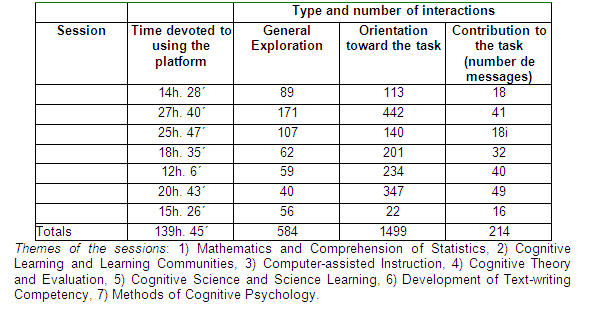
According to the data presented in Table I, the total interaction time of the participants (seven students and the teacher) was 139 hrs. and 45 minutes, which represents an average of 17 hours and 30 minutes of interaction per participant. That is to say, each participant invested an average of two hours and fifteen minutes per session, plus the interaction in the classroom. The data in Table I shows that in the first two sessions, the interaction time devoted to the category of general exploration was increasing; however, from the third to the seventh session, a decrease in such interaction time was shown.
The previous data regarding interaction time devoted to the platform seems to be related with a more or less gradual decrease in the number of interactions corresponding to the category of platform exploration. This may be explained by that fact that once the students became familiarized with the tools, they could orient themselves more and more toward the task itself. Sessions 2 and 6 are those which present the greatest number of messages (contributions to the task: 41 and 49 respectively). These data reflect an important investment of time on the part of the students, since to enter a message in the forum, the students had to look at the forums; find in them the answers other students had previously given; find a discussion thread; read the previous messages; and then make their contribution. This long process could be related with the advantages which have been attributed to CMC, in the sense of promoting greater reflectivity and a higher level of critical thinking than in face-to-face interaction.
5.2 Content of the interactions
To develop this analysis, the messages were segmented according to Chir's proposal (1997), considering complete ideas. The segments were codified by two independent observers, and an index of inter-observer reliability of 77.85% was obtained. Tables II and III present the data of the interaction categories in which the participants were involved in both forums (with and without the present of the teacher).
Table II. Percentage of categories with the three types of participants' presence
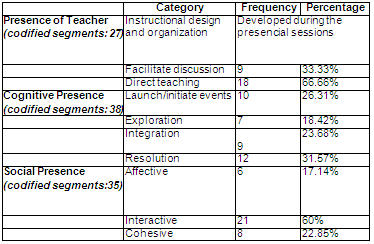
Table III. Percentage de categories with the three types of participants' presence
in Forum 2 (students and teacher)
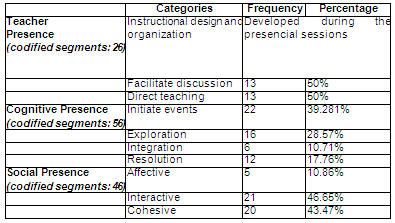
As we may observe in Tables II and III, the category Teacher Presence is included to describe both the participations of the instructor in Forum 2, and of the two students in Forum 1, since these last also assumed the role of teacher. The category of Instructional Design and Organization of the Course was not codified in either of the two forums, in view of the fact that this activity was carried out in the presencial sessions. In Forum 1, the students devoted the major part of their interactions to direct teaching, principally related with answering discussion questions (66.6%), and in lesser measure to the facilitation of discussion (33.33%). In Forum 2, the teacher divided the interaction time between facilitating discussion and direct teaching.
In Table II, the category Cognitive Presence shows that students devoted a higher percentage to the category of Resolution (31.57%), than the percentage shown in the forum with Teacher Presence (17.76%). This contrasts with the percentage of interactions which the teacher (Table III), devoted to launching/initiating events (39.28%) and to the exploration of ideas (28.57%), versus 26.31% (launching/initiating events) and 18.42% (exploration of ideas) in the students' forum.
Social Presence shows the highest level in the category of Interaction (60% Forum 1 and 46.65% Forum 2), followed by the category of Cohesion (22.85% y 43.47%). These data indicate that the students used forms of social interaction in which prevailed the asking of questions or making reference to the messages of others, without including cohesive aspects such as those used in greater measure by the teacher in making explicit reference to the outstanding aspects of the students' contributions.
VI. Qualitative Analysis
To carry out this type of analysis, the complete, unsegmented messages included in Forums 1 and 2 were considered, and were categorized according to the levels of knowledge construction put forth by Gunawardena et al. (1997). As well, the discourse strategies used by the teacher in Forum 2 were located as Lemke expected them (1997).
Tables IV y V present some fragments of the interactions of the participants and of the categories used for the analysis.
Table IV. Construction of knowledge in Forum 1, phase 1

Table V. Knowledge construction in Forum 1, phase 2
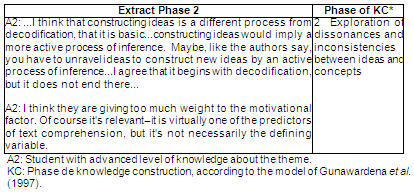
6.1 Forum without the presence of the teacher
In those students with a lower level of previous knowledge (Table IV), there was observed an effort to synthesize and to answer the questions (phase 1 of the model of Gunawardena, et al. (1997), while in the students with a greater level of previous knowledge it was possible to find evidence of statemensts evidencing critical thinking, and justification for these (phase 2), (see Tables IV and V).
6.2 Forum with the presence of the l teacher
Tables VI and VII present examples of the levels achieved by students in the construction of knowledge, such as pedagogical and discourse strategies used by the tutor to support reaching these levels
Table VI. Strategies used by the tutor to support the construction of knowledge in Forum 2
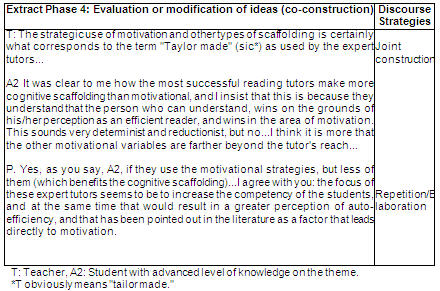
Table VII. Type of strategies used by the tutor to support knowledge construction
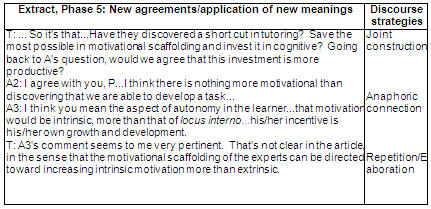
VII. Discussion and conclusions
The methodological strategy of analysis presented in this work permitted the description and analysis of various aspects linked with the patterns of interaction in virtual forums. Quantitative analysis revealed that a considerable number of interactions are required, and because of this, an extended portion of time is required for the students to make contributions to the task, as supported by the work of Chickering and Ehrmann (1996), in the sense that the asynchronicity of communication favors greater reflection regarding the content of the course.
In reference to the content of the interactions developed in the forums analyzed, it was found that without the presence of the teacher, the students jumped rapidly from the exploration of ideas to the solutions, without showing a deep comprehension of the topics under consideration. On the other hand, in the forum in which the teacher was present, this initiated a greater number of events and triggered a broader exploration of the ideas before a conclusion was reached. These data underline both the value of Instructional Design, which shows the value of discussion in the forum, since it facilitated the exploration and clarification of the ideas previously brought up in face-to-face discussion; and the teacher's decisively important role in involving the students in critical discussions of the content of the instruction.
The qualitative analysis revealed that the 41 contributions registered in Forum 1 were located in Phases 1 and 2 of the Knowledge Construction process. In Forum 2, the pedagogical and discourse strategies used by the teacher make it possible for the students who have greater previous knowledge to advance to phases 3, 4 y 5 of the model proposed by Gunawardena et al. (1997).
References
Anderson, T., Rourke, L., Garrison, D. R., & Archer, W., (2001). Assessing teaching presence in a computer conferencing context. Journal of the Asynchronous Learning Network, 5 (2). Retrieved February 15, 2005, form: http://www.sloan-c.org/publications/jaln/v5n2/v5n2_anderson.asp
Barab, S. A., Kling, R., & Gray, J. H. (2004). Designing for virtual communities in the service of learning. Cambridge: Cambridge University Press.
Barab, S. A. & Plucker, J. A. (2002). Smart people or smart contexts? Cognition, ability, and talent development in an age of situated approaches to knowing and learning. Educational Psychologist, 37 (3), 165-182.
Benbunan-Fich, R., Hiltz, R. & Harasim, L. (2005). The online interaction learning model: An integrated theoretical framework for learning networks. In S. R. Hiltz & R. Goldman (Eds.), Learning together online: Research on asynchronous learning networks (pp. 19-37). Mahwah, NJ: Lawrence Erlbaum Publishers.
Chi, M. (1997). Quantifying qualitative analyses of verbal data: A practical guide. The Journal of the Learning Sciences, 6 (3), 271-315.
Chickering, A. W. & Ehrmann, S. (1996). Implementing the seven principles: Technology as lever. AAHE Bulletin, 49 (2), 3-6.
Clark, R. (1983). Reconsidering research on learning from media. Review of Educational Research, 53 (4), 445-459.
Clark, R. (1994). Media will never influence learning. Educational Technology Research and Development, 42 (2), 21-29.
Cleveland-Innes, M. & Emes, C. (2005). Social and academic interaction in higher education contexts and the effect on deep learning. National Association of Student Personnel Administrators Journal, 42 (2), 241-262.
Coll, C. (2004). Psicología de la educación y prácticas educativas mediadas por las tecnologías de la información y la comunicación. Una mirada constructivista. Sinéctica, 25, 1-24.
Eastmond, D. V. (1995). Alone but together: Adult distance study through computer conferencing. Cresskill, NJ: Hampton Press.
Fishman, D. B. (2000). Transcending the efficacy versus effectiveness research debate: Proposal for a new, electronic. Journal of Pragmatic Case Studies. Retrieved October 15, 2004, from: http://journals.apa.org/prevention/volume3/pre0030008a.html
García, B., Secundino, N., & Navarro, F. (2000). El análisis de la práctica: consideraciones metodológicas. In M. Rueda & F. Díaz-Barriga (Comps.), La evaluación de la docencia. Perspectivas actuales (pp. 179-208). México: Paidós.
Garrison, D.R. & Anderson, T. (2003). E-Learning in the 21st Century: A framework for research and practice. New York: Routledge Falmer.
Garrison, R., Anderson, T. & Archer, W. (2000). Critical inquiry in a text-based environment: Computer Conferencing in Higher Education. The Internet and Higher Education, 2 (2-3), 87-105.
Garrison, D. R. & Cleveland-Innes, M. (2005). Facilitating cognitive presence in online learning: Interaction is not enough. American Journal of Distance Education, 19 (3), 133-148.
Graham, C. R. & Misanchuk, M. (2004). Computer-mediated teamwork: Benefits and challenges of using teamwork in online learning environments. In T. S. Roberts (Ed.), Online collaborative learning: Theory and practice (pp. 181-202). Hershey, PA: Idea Group.
Gunawardena, C., Lowe, C., & Anderson, T. (1997). Analysis of a global online debate and the development of an interaction analysis model for examining social construction of knowledge in computer conferencing. Journal of Educational Computing Research, 17 (4), 397-431.
Hawisher, G. E. & Pemberton, M. A. (1997). Writing across the curriculum encounters asynchronous learning networks or WAC meets up with ALN. Journal of Asynchronous Learning Networks, 1 (1), 52–72.
Järvelä, S. & Häkkinen, P. (2002). Web-based cases in teaching and learning: The quality of discussions and a stage of perspective taking in asynchronous communication. Interactive Learning Environments, 10, 1-22.
Jong-Baeg, K., Derry, S., Steinkuehler, C., Street, J., & Watson, J. (2000). Web-based online collaborative learning. Paper presented at American Educational Research Association Annual Meeting, New Orleans, Louisiana.
Kozma, R. (1994). Will media influence learning? Reframing the debate. Educational Technology Research and Development, 42 (2), 7-19.
Lemke, J. (1997). Aprender a hablar ciencia. Lenguaje, aprendizaje y valores. México: Paidós.
Translator: Lessie Evona York-Weatherman
UABC Mexicali
Please cite the source as:
García, B., Márquez, L., Bustos, A., Miranda, G. A., & Espíndola S. M. (2008). Analysis of Patterns of Interaction and Knowledge Construction in Online Learning Environments: A Methodological Strategy. Revista Electrónica de Investigación Educativa, 10 (1). Retrieved month day, year from:
http://redie.uabc.mx/vol7no1/contents-bustos.html







